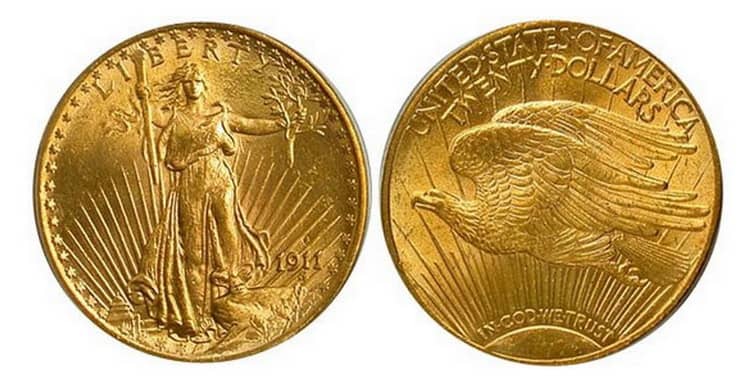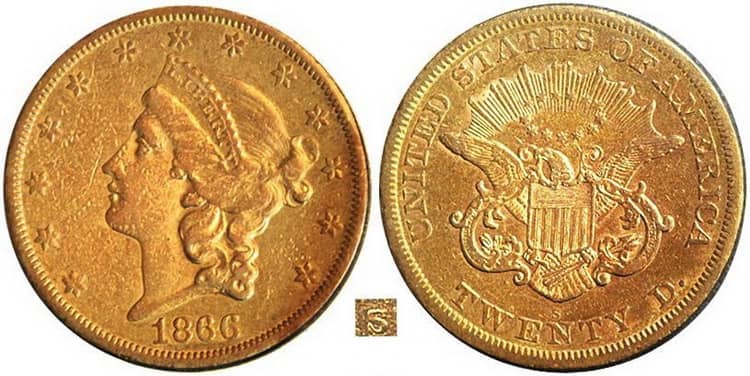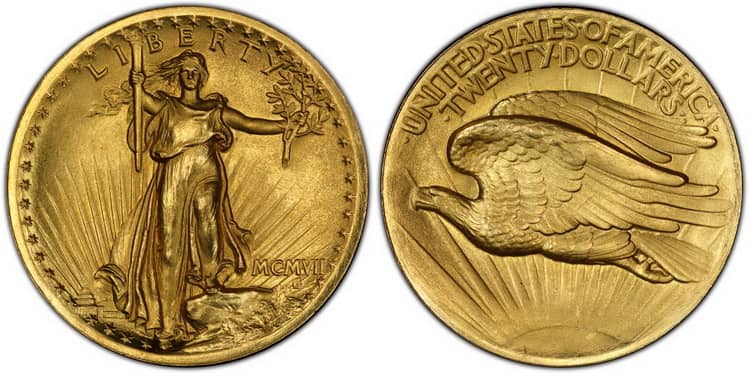
Double Eagle is the gold coin of $ USD 20 minted in 1849-1933. A sample with such a high denomination has appeared, thanks to the legendary “gold rush” in California. In 1933, coins were withdrawn from circulation due to the abandonment of the gold standard and the economic crisis called the Great Depression. One of the few surviving samples recognized the most beautiful and most expensive US coin.
History
In 1838, huge reserves of gold were found in California. The precious metal was mined in such a quantity that it was decided to build the Mint in the city and mint money for the development of the country’s economy. By 1853, 373 tons of gold was produced in California rivers. From it minted $ USD 2.5 – a quarter of an eagle, $ USD 5 – a half of an eagle, $ USD 10 – an eagle and $ USD 20 – a double eagle of the USA. Gold mines uninterruptedly supplied the precious metal from 1849 to 1933.
Did you know? In the period from 1849 to 1933, the Double Eagle became the heaviest coin with the largest denomination. Gold copy helped the development of the US economy. For 80 years, $ USD 20 was at the center of the economic system, ensuring the stability and liquidity of the US currency, which contributed to improving the country’s financial situation. US money was received in neighboring countries, across Europe, in the countries of North Africa and in Asia, which had a significant impact on international trade.
In 1933, the Great Depression began in the United States. Many countries have abandoned the gold standard. This year, the California Mint produced 445,500 coins, but they did not go into circulation. By the decree of Franklin Roosevelt No. 6102, gold coins that are among the people were outlawed. The population was required to return the gold coins, including the Eagle and the Double Eagle to the treasury. Failure to comply with the law was punishable by a large fine and imprisonment for 10 years.

Unused coins of 20 US dollars of 1933, according to the documents, were to be melted back into gold bars. Mint Chief Cashier George McCann disagreed with this decision. A double eagle with a beautiful and thoughtful design by Augustus Saint-Gaudens over the years could have cost well above its nominal value. The official saved from destruction of 20 gold coins an eagle. Later, the US intelligence services found and seized almost all the assigned dollars. The fate of one of them was unknown.
Unused coins of 20 US dollars of 1933, according to the documents, were to be melted back into gold bars. Mint Chief Cashier George McCann disagreed with this decision. A double eagle with a beautiful and thoughtful design by Augustus Saint-Gaudens over the years could have cost well above its nominal value. The official saved from destruction of 20 gold coins an eagle. Later, the US intelligence services found and seized almost all the assigned dollars. The fate of one of them was unknown.
In 1940, Saint Gaudens’ American Double Eagle was spotted in Egypt in the collection of King Farukh. There was no response to the demand to return the coin back to the USA. In 1952, Farukh was expelled from the country, and in 1955 $ USD 20 was put up for auction, but at the protest of the American special services it was withdrawn from sale. In 1966, the gold coin reappeared at auction, but in London. It is not known how the gold coin turned out to be from Stephen Fenton. He exhibited a precious sample for $ USD 1 million. The transaction did not take place because the Double Eagle was considered the property and value of the United States.
Did you know? In the years 1900-1914, the working population of the United States was in better condition than the inhabitants in Europe. According to the Bureau of Statistics, a family of 5 people could live on $ USD 14.5 a week, and to meet the minimum needs of a family, it was enough to receive $ USD 10 a week. On average, men in 1899 received $ USD 11.2, and in 1914 – $ USD 15.4. The salaries of women, respectively, were $ USD 6 and $ USD 8.2.
The litigation between the US government and Stephen Fenton lasted 5 years. By agreement of the parties, they decided to sell the gold coin through an auction, and divide the money between them. In 2002, the Sotheby’s auction set up a Double Eagle for $ USD 2.5 million with a minimum step of $ USD 100,000. The total price of the ransom was $ USD 6.6 million, and with the auction commission $ USD 7,590,020. Thus, the Double Eagle gold coin became the most expensive in the history of numismatics.

In 1986, the United States decided to mint investment coins made of precious metals. Samples of 5, 10 and 20 and 50 dollars with the design of Saint-Gaudens were available in four weight categories. The most popular was the American Gold Eagle Coin Series and the American Silver Eagle Coin Series. Samples of platinum supplemented the collection in 1997.
Design
From 1949 to 1933, three types of Double Eagle gold coins were minted, but each new sample contained three traditional symbols of the USA – Liberty, eagle and stars (by the number of states). The first editions were released without the inscription “GOD”. In 1866 (after the end of the Civil War), the reverse was supplemented with the slogan “IN GOD WE TRUST”.

In 1877, the design of the Double Eagle was entrusted to the main engraver of the Mint, Charles Barber. He slightly changed the image of Freedom and the bald eagle. Also, the master changed the nominal value from “TWENTY D.” to “TWENTY DOLLARS”. In this form, the gold coin lasted until 1907, until it was replaced by the legendary Double Eagle of Saint-Gaudens. The image on the surface of the coin significantly changed, so it was recognized as the most beautiful means of payment of the United States.
President Theodore Roosevelt thought that the design of Charles Barber was boring and simple, so he turned to his friend, sculptor Augustus St. Godens, for help. The master responsibly approached the work. He replaced the portrait of Liberty with the image of a walking woman in full growth, put an olive branch and a torch in her hands. Initially, the relief of the gold coin was supposed to increase, the dates denoted by Roman numerals and remove the inscription “IN GOD WE TRUST”. Charles Barber in every way prevented to implement all the ideas of Saint-Gaudens, so the Roman numerals, the motto and the former relief left.
Did you know? From 1904 to 1907, the Double Eagle of Saint-Gaudens could not be put into production, because Theodore Roosevelt required to Mint a gold coin with a high relief, but Charles Barber refused to do so. On the production there were no machines that allow to carry out the idea of Saint-Gaudens. To produce a regular coinage coin, it took 1 punch of the press, and to release the Double Eagle with a high relief, it was necessary to carry out 9 strokes. The regular coinage of these coins was impractical.
Characteristics of the “Double Eagle” gold coin


Material: gold.
Sample: 90%.
Weight: 33.4 grams.
Par: 20 dollars.
Diameter: 34 mm.
Quality: Regular chasing.
Edge: smooth with the inscription: E PLURIBUS UNUM (the Unity of many), the inscription is shared by relief stars by the number of US states.
Modern investment gold coins Double Eagle minted with a weight of 1 ounce as Brilliant Uncirculated or Proof.
Obverse: The front side shows Liberty at full length, striding forward. In one hand she holds a big torch, in the other she lifts an olive branch. To the left of the woman is a small fragment of the Capitol, behind the rays of the sun. Above Liberty’s head, the inscription LIBERTY goes 48 in a circle (50 stars after 1912) in the number of US states. On the right is the year of coinage.
Reverse: On the reverse side, there is the symbol of the USA is the bald eagle in flight against the background of the rays. On the upper edge are the inscriptions UNITED STATES OF AMERICA and TWENTY DOLLARS. On the bottom edge is the motto IN GOD WE TRUST.
Circulation
From 1949 to 1907, 100,000,000 Double Eagles were minted, designed by engraver James Longcr. From 1907 to 1933, Saint-Gaudens gold coins were issued. The total circulation of all time was 65 million pieces, in the last year 455,500 copies were minted.
Did you know? The $ USD 20 in the US of 1849-1933 was a significant amount. The average salary of a resident of America was $ USD 3-5 per month. In the people, gold coins of 1, 2.5 and 5 US dollars were popular. Copies of $ 10 and $ USD 20 were produced for international trade. Most of the gold coins went to the restoration of Europe after the devastating World War I.
Cost of coins
All copies of the Saint-Gaudens Double Eagle are held at Fort Knox and are not for sale. Modern investment samples cost the collector $ USD 1200 – a little higher than the current value of the precious metal. In 2009, the Mint produced a small circulation of gold coins in the form in which Theodore Roosevelt and Augustus Saint-Gaudens wanted to see them. Roman numerals with high relief sold out for $ USD 5,000 apiece.
Comments
No commens yet.